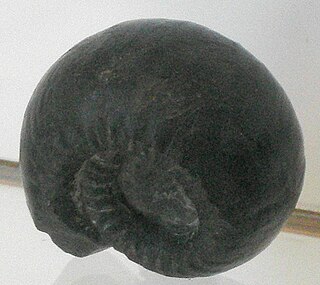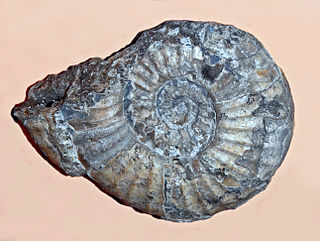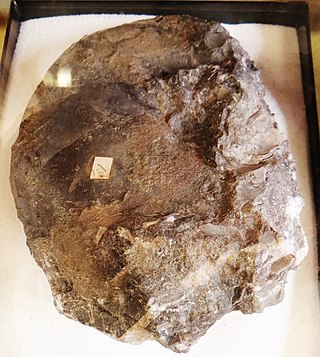Acrimeroceras is an oxyconic Devonian goniatite and one of three genera included in the subfamily Paratornoceratinae. The others being Paratornoceras and Paratoceras or exPolonites.
Asapholytoceras is a lytoceratid ammonite, originally from the upper Lower Jurassic of southeastern Europe with high, compressed whorls and a sharp angle to the umbilical shoulder. The exposed suture has four primary lobes on either side; the internal dorsal lobe is not cruciform.

Audaxlytoceras is an extinct genus of lytoceratid ammonites.
Frechites is an early Triassic ammonite, a kind of cephalopod with an external shell, included in the ceratitid family Beyrichitidae.
Ussuria is a genus of Lower Triassic ammonites with a smooth, involute discoidal shell with submonophyllic sutures, belonging to the ceratitid family Ussuriidae.

Lytoceratina is a suborder of Jurassic and Cretaceous ammonites that produced loosely coiled, evolute and gyroconic shells in which the sutural element are said to have complex moss-like endings.

Gastrioceratoidea is one of 17 superfamilies in the suborder Goniatitina, ammonoid cephalopods from the Late Paleozoic.

Psiloceratoidea is a superfamily of Early Jurassic ammonoid cephalopods proposed by Hyatt in 1867, assigned to the order Ammonitida. They were very successful during Hettangian and Sinemurian. Last of them, family Cymbitidae and genera Hypoxynoticeras and Radstockiceras survived into Early Pliensbachian.
Syringonautilidae is a family of Nautiloidea from the middle to late Triassic. Syringonautilidae comprise the last of the Trigonoceratoidea and are the source for the Nautilaceae which continued the Nautiloidea through the Mesozoic and into the Cenozoic right down to the recent. Syringonautilidae is a strictly Triassic family, derived early in the Triassic from the Grypoceratidae.
The Centroceratidae is the ancestral family of the Trigonoceratoidea and of the equivalent Centroceratina; extinct shelled cephalopods belonging to the order Nautilida
The Naedyceras group comprises three similar and closely related openly coiled, gyroconic, genera within oncocerid family, Brevicoceratidae: Naedyceras, Gonionaedyceras, and Gyronaedyceras.

Carenzia trispinosa is a species of sea snail, a marine gastropod mollusk in the family Seguenziidae.
Bisatoceras is a late Paleozoic Ammonoidea, a member of the goniatitid family Bisatoceratidae.

Barrandeoceras is a large, coiled, Middle Ordovician nautiloid cephalopod and part of the Tarphycerida. The shell is serpenticonic with whorls touching but not embracing. The adult body chamber becomes freed of the preceding whorl, a rather common character among tarphycerids. Whorl section is oval, somewhat more narrowly rounded ventrally, on the outer rim, than dorsally, on the inner rim. Prominent lateral ribs, at least on inner whorls. Grow lines show a distinct hyponomic sinus. Sutures have lateral lobes. The siphuncle is subcentral.
Megalytoceratinae is a subfamily of lytoceratids ammonites consisting of planulate forms, i.e. those with moderately evolute compressed shells with bluntly rounded venters, in which the outer whorls become smooth and sutures tend to resemble those of the Perisphinctidae. The family includes three genera, Megalytoceras, and Metrolytoceras, from the Middle Bajocian of England, Perilytoceras from the Toarcian and a fourth possible member, Asapholytoceras, from the Toacian of southeastern Europe.
Alocolytoceratinae is a subfamily of lytoceratids that comprises genera characterized by many deep constrictions in the shell resulting in capricorn-like ornamention, especially in the middle whorls, but becoming smooth and more involute in the outer whorls. Saddle endings in the suture tend to be phylloid, (leaf-like).

Lytoceratinae is a subfamily of ammonoid cephalopods that make up part of the family Lytoceratidae.

The family Dactylioceratidae comprises Early Jurassic ammonite genera with ribbed and commonly tuberculate shells that resembled later Middle Jurassic stephanoceratids and Upper Jurassic perisphinctids. Shells may be either evolute or involute.
Aulacaganides is monospecific genus of a Middle Permian ammonite belonging to the goniatitid family Pseudohaloritidae. Fossils belonging to this genera were found in Hunan province of China.

The subfamily Reynesocoeloceratinae comprises early Jurassic ammonite genera that lived during Pliensbachian stage. These dactylioceratids existed from Ibex ammonite zone and died out in Spinatum zone. They have evolved from Metaderoceras and gave rise to subfamily Dactylioceratinae.









